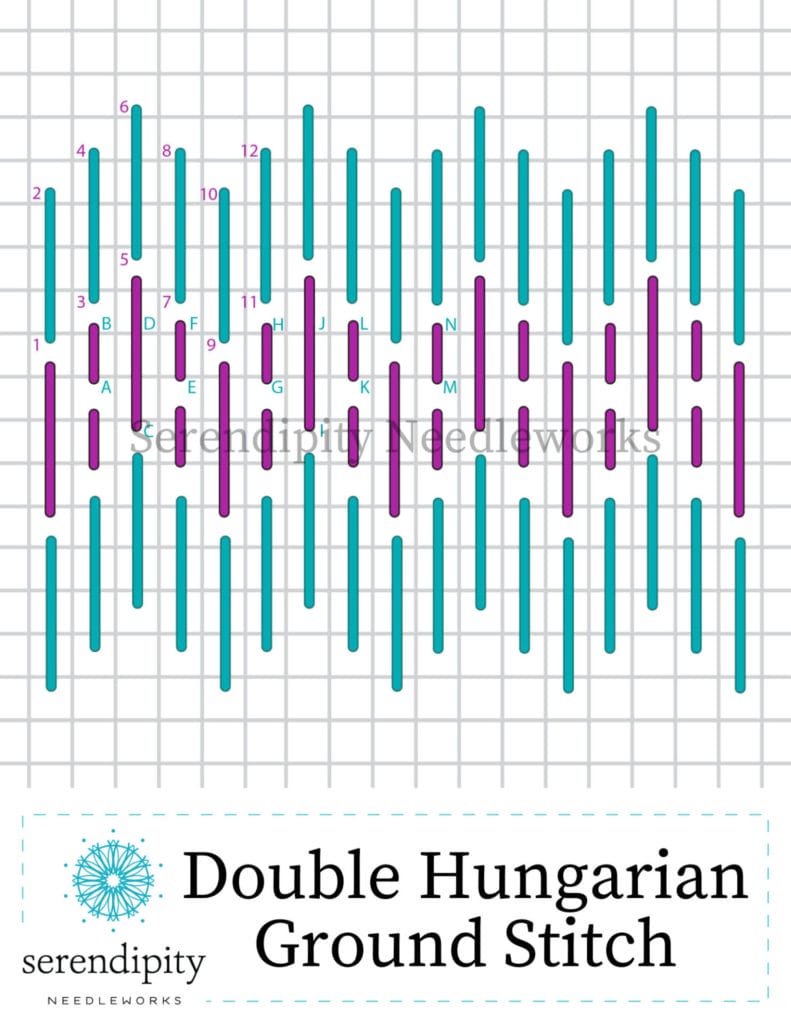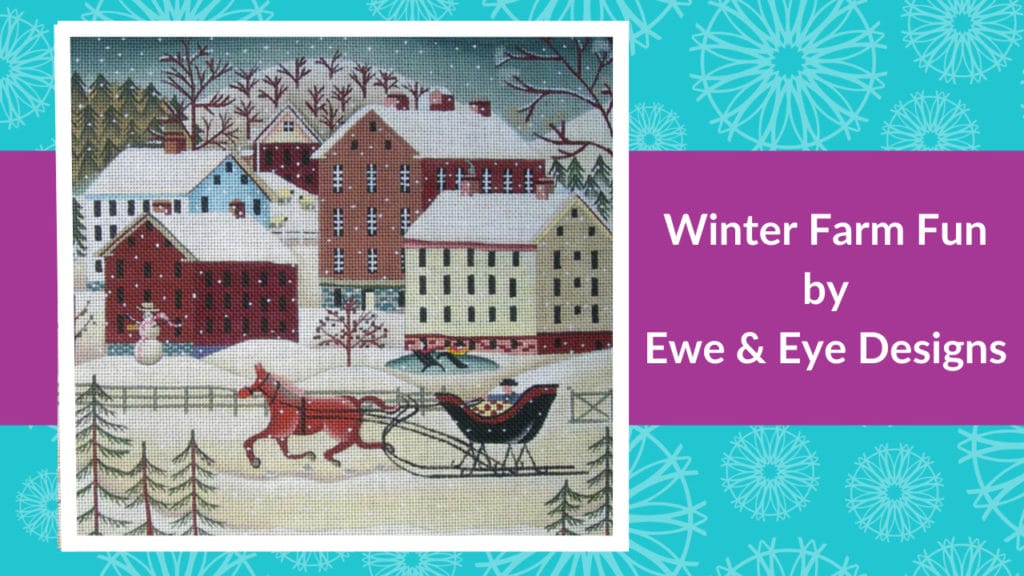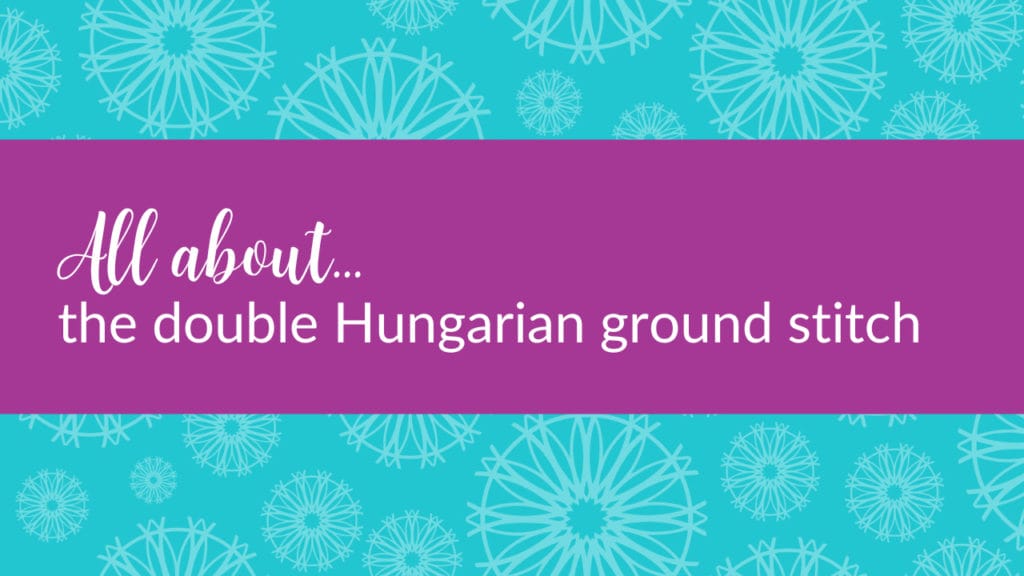This week, we’re celebrating Serendipity Needleworks’ twentieth birthday and part of the celebration includes opening enrollment in The Stitcher’s Club™. The Stitcher’s Club is where I teach needlepointers how to choose the best stitches and threads for their projects. You can learn more about it here.
The How-To Stitch Library inside The Stitcher’s Club includes full color stitch diagrams for more than 200 decorative stitches. (And there are video tutorials for more than 150 of those stitches, with more being added every month. 😉 )
One of the stitches in the How-To Stitch Library is the Double Hungarian Ground Stitch.
The double Hungarian ground stitch is a member of the straight stitch family. It is a composite stitch. That means it’s composed of two different stitches to create a new pattern: the Hungarian stitch and the Gobelin stitch. In this case, the Gobelin stitch is worked in a Florentine (aka Bargello) pattern (over 4 canvas threads).
Here’s the diagram for you…

Notice how the diagram for the double Hungarian ground stitch has both numbers and letters?
Well, that’s because you should work this stitch in two steps. Begin by executing the Gobelin stitch portion, then go back and fill in the Hungarian stitch units. And here’s a little tip for you – as with all decorative stitches, when you’re working with multi-colored threads, it’s always best to compensate as you stitch so that the flow of color remains intact. (Compensating is when you adjust a stitch/stitch pattern to fit into a particular space on your canvas.)
The double Hungarian ground stitch is most effective, I think, when it is worked with two different textures of the same color of thread. But you may also use two completely different colors. That approach just results in a more bold look.
One of my favorite ways to use the double Hungarian ground stitch is for snow…
so let’s take a peek at some different thread combinations that you can use to make the snowy areas on your canvas sparkle.

If your canvas is a wintry landscape, like “Winter Farm Fun” from Ewe and Eye Designs, you might consider pairing Petite Frosty Rays with Flair. Another winning combo is Neon Rays and Neon Rays +. Both pairs will create a glimmering snow covered ground – and each of those threads will work beautifully for either portion of the stitch pattern. Since they’re all flat, ribbon-type threads, you may use them on both 13 and 18 mesh canvas.
Other lovely combinations for fluffy snow include Fuzzy Stuff + Very Velvet for 18 mesh canvas and Arctic Rays + Flair for 13 mesh canvas. My personal preference is to use Fuzzy Stuff or Flair for the Gobelin portion of the stitch pattern and Very Velvet or Arctic Rays for the Hungarian stitch units.
The double Hungarian ground stitch is also a terrific option for woodland paths and country roads.
Some threads to consider include Rainbow Tweed, Londonderry Linen, Watercolours, Wildflowers, Mandarin Floss, and DMC Cotton Embroidery Floss.
One of my favorite tips for pairing threads with stitches is to match the texture of the thread with the texture of the design component. That’s why all of the threads I suggested for the path/road design components are rough or have a matte finish.
Moving right along…
One last way that you can use the double Hungarian ground stitch on your needlepoint projects is for backgrounds!
In fact, this stitch is fantabulous for making quick work of backgrounds – especially on larger canvases.
If you’ve been following me for a while, you know I believe that simplicity is the ultimate sophistication – and that means using one color of thread when employing the double Hungarian ground stitch for a background. You can absolutely use two different textures to add a bit of visual interest, though. For example, you might consider Splendor + Silk Lamé Braid. (I recommend using Splendor for the Gobelin stitch portion of the pattern and Silk Lamé Braid for the Hungarian stitch section.) There are oodles of other combinations that you might try, too, so grab a doodle canvas and have some fun!!
Alrighty, my friend – that brings us to the end of our chat about the double Hungarian ground stitch. I hope you’ve enjoyed reading about this versatile little stitch. If you use it on one of your projects, please let me know. (And don’t forget tell me how you used it, too…it’s always super fun for me to hear from you. 🙂 )
Until next time, happy stitching…
XOXO!






OOOOH – I like the looks of this stitch, but how about showing some examples, especially what this stitch looks like for snow?
Hi Georgia!
I’ll see what I can do about adding some pictures in the How-To Stitch Library or Which Stitch? inside your Stitcher’s Club Member Portal. 😉
XOXOX!
Ellen
Thank you for all the suggestions and ideas. I can’ wait to try the double Hungarian.
You’re very welcome, Laura! Happy stitching…
XOXO!
Ellen